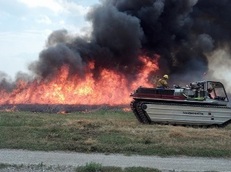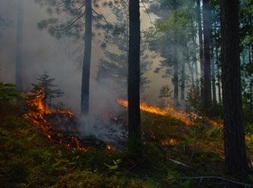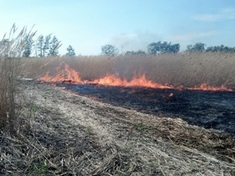Prescribed burns on Michigan’s state forest lands
Thank you for your interest in the Department of Natural Resources’ prescribed burn program. We wanted to take a few minutes to provide background about these carefully managed fires that are necessary to restoring and maintaining Michigan’s natural ecosystems.
Prescribed burns are planned to achieve specific objectives – oftentimes simulating the benefits of natural fires. The burns are conducted in designated state-managed areas during appropriate weather conditions and in cooperation with the proper authorities.
 Prescribed burns are used to:
- Improve wildlife habitat;
- Help with forest regeneration;
- Restore and maintain native plant life;
- Control invasive plant species; and
- Reduce the risk of wildfires.
Most prescribed fires are conducted from spring to late fall, but they can be planned for other seasons if the ecological and safety objectives are met. Marsh burns are sometimes conducted in winter.
|
Bill O’Neill, chief of the DNR’s Forest Resources Division, said his team often tries to plan burns for specific days, but – because these events are entirely weather-dependent – plans can change at any time. This is why the notifications will almost always be sent as the burn process is under way. Each DNR notification message will include a general description of where the prescribed burn is taking place, but – due to the uncertainty of many factors, including the unpredictability of the weather – will not offer a specific location.
“We are simply trying to keep people safe,” said O’Neill, who also serves as Michigan’s state forester. “During a prescribed burn, we don’t want anyone in harm’s way – that includes the public and our fire staff. To ensure a burn goes as planned, our crew needs to be able to focus solely on the burn, from the point of ignition to the time the smoke clears.”
 Why fire?
Fire is a natural ecosystem process. Naturally occurring fires have played a critical role in shaping much of the natural landscape of Michigan. Our natural resources include many fire-dependent areas, including prairies, savannas, oak woodlands, pine forests and wetlands. Fire helps set back encroaching shrubs and trees, stimulates native plants and fertilizes the soil by releasing nitrogen and providing ash.
“It may seem contradictory, but fires are absolutely critical to keeping Michigan’s forest lands – and the wildlife and habitat they support – healthy,” O’Neill said. “Our native plants and animals are adapted to coexist with fire. When a prescribed burn occurs, birds and animals instinctively know to move out of the area.”
|
Are they safe?
Before any burn is conducted, experienced and trained DNR fire staff studies the area and carefully develops a burn plan to maximize the effects of fire behavior while assuring safety procedures are in place. The burn plan is essentially the "prescription" for how to conduct the burn safely while accomplishing the management objectives.
Burn plans include a detailed account of:
- Atmospheric conditions such as humidity, wind speed, direction and temperature;
- Vegetation fuel types and conditions;
- The gaps in vegetation or other combustible material that act as a barrier to slow or stop the progress of a fire (also known as a fire break);
- Equipment and personnel needs;
- The ignition plan;
- Smoke management;
- Contingency plans; and
-
Public notification, including federal and county dispatchers, public safety departments, local power companies and any large organization that may be affected by the burn. The DNR will also make contact with private landowners near the planned burn area.
 The burn plan focuses on minimizing the effects of smoke, and also ensuring that the fire stays well within the established perimeter. Although the plan is reviewed and approved well in advance, the actual burn must get a final approval the morning of a burn after DNR fire staff go over a rigorous go/no-go checklist. If conditions are not favorable, the “burn boss” can cancel a burn at any time.
In addition to the burn plan, specialized equipment is on site to assist in controlling fire behavior.
What happens after a burn?
Burned areas generally "green up" quickly, often in as little as a week or two. Sunlight warms the dark ash-covered soil, creating an ideal environment for plant growth.
So far in 2012, the DNR has conducted 37 prescribed fires, burning nearly 2,163 acres.
|
The Michigan Department of Natural Resources is committed to the conservation, protection, management, use and enjoyment of the state’s natural and cultural resources for current and future generations. For more information, go to www.michigan.gov/dnr.
|